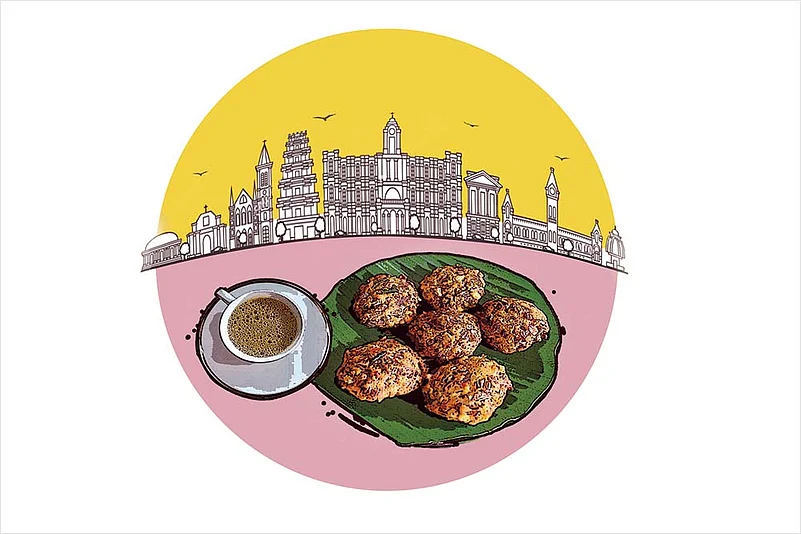Food is uppermost on my mind whenever I go to Madras—as I still call Chennai because Madras is the emotion I’ve known since 1969 when I first set sight on India’s “intellectual capital”, as Nehru called it. And, Madras never disappoints the food-loving Madrasi, often called Sappatturaman by older folks who cannot bear to see hearty eaters. There’s always something new to tickle the taste buds.
On this visit, I discovered vazhaipoo vadai—banana blossom vadai. It’s the tastiest vadai I’ve ever had and I had it daily during my recent 10-day stay in Valasaravakkam, Chennai. Soft inside, the outer layer is a crisp brown crust. It is the King of Vadais on Chennai’s snack scene. The other vadais—medhu, thavalai, keerai, cabbage, parippu, thattu, Maddur—are very much there, but not on top of anyone’s list. The vanilla medhu vadai is standard companion of idli and pongal at breakfast in most eateries in Madras. But it is as an evening indulgence, especially in the roadside tea kadai (shop), which thrives across the city, that the vadai occupies pride of place. Madrasis love their vadais, which come in a variety of flavours, shapes and sizes. Until vazhaipoo vadai crashed the scene, the teashops’ evening fare usually was medhu vadai, parippu vadai, Mysore bonda and vazhakkai bajji (raw banana fritters) with samosa added on at a few outlets.
In fact, these teashops are a new class of subaltern eateries. No tables, chairs, lights, fans, waiters or cleaners. In most places, you stand and eat from disposable plates. At best, there are stools to sit for four to six customers with a slab of stone for a table. And, it’s hard to find an hour when there is no queue for buying vazhaipoo vadai.
The popularity of the vazhaipoo vadai and mushrooming of the new subaltern eateries selling tea and filter coffee are part of a new food culture exploding in Chennai: organic, native, street food that bids fair to beat the traditional idli-dosai restaurants as well as the vadai-bonda-bajji tea stalls. These shops offer a choice of traditional stuff—such as ragi kozhukottai (steamed modak) made with native palm jaggery, cumbu (millet) laddoo and adai (dosai from batter made with a mix of lentils)—which were till now confined to the countryside or only made at home. These are often alongside a new type of “upstart” tea stalls, set apart by their beverage menu: they offer a range of teas and selections of good freshly-brewed filter kaapi, with or without milk, and with a choice of sugars: palm, brown, white and nattu sakkarai.
As Chennai prepares itself to become a “smart city”, it is marked not only by this new organic food culture emerging from below, but also impositions of urban features from above. “Have you seen Pondy Bazaar now?” The question pops up often. So I checkedπ. It is a 1.5-km stretch of Thyagaraya Road leading off Panagal Park in T. Nagar—the city’s shopping centre with a maze of streets that would defy Google Maps. The road, unusually wide for Chennai, has even wider footpaths, which until some years ago was occupied by hawkers and vendors selling everything from cut-pieces of cloth to peanuts. One had to navigate through pavement-sellers and their wares to get to the shops and restaurants.
Pondy Bazaar has been given a makeover now: turned into a swanky pedestrian plaza with bollards marking off the 800-metre territory. Against a backdrop of wall murals are play areas for children and benches to sit under a canopy of trees; and buggies to ferry senior citizens. The streetlights make it more alive at night. All these for about Rs 38 crore under the Smart City Project. It is Chennai’s favourite new hangout. Local authorities, flattered by its effect on the public, are planning more such smart spaces. On the flipside, Pondy Bazaar is now a bazaar without vendors and that too in T. Nagar—known for its street shopping. The over 600 ‘shops’ and street vendors, who have been moved into a new building, complain that business was hit when the plaza was being built; and remains poor. Footfalls in the plaza cannot feed us, a bangle-seller says.
Madras has become Chennai. Madrasis are going places and have a smart city as well. What more could they want? “Water, saar,” a neighbour says. Chennai has a water problem. Reports say piped supply to homes is not even 10 per cent of what it used to be, and the wait for tankers is getting longer each year. The months in a year when Chennai has not had water scarcity in recent decades can be counted on the fingers of one hand. How smart would a smart city be without a perennial water source to sustain it?
















